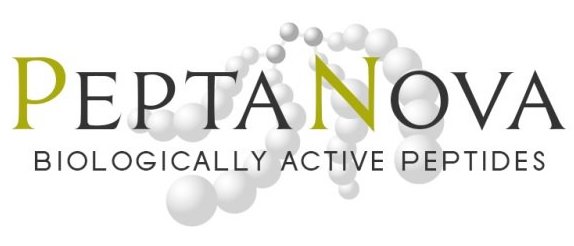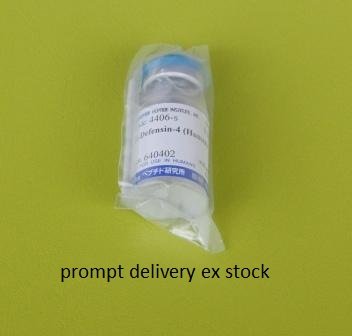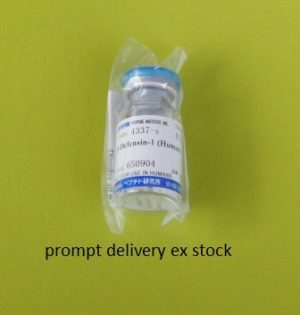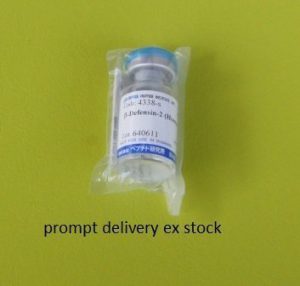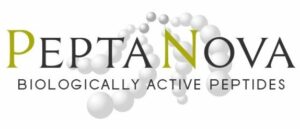Beta-Defensin-4 (Human)
Human β-Defensin-4 | hBD-4 | Prepro-hBD-4 (Human, 26-61)
4406-s 0.1 mg | 235.00 EUR
Synthetic Product (disulfide bonds between Cys6-Cys33, Cys13-Cys27 and Cys17-Cys34)
Glu – Leu – Asp – Arg – Ile – Cys – Gly – Tyr- Gly – Thr – Ala – Arg – Cys – Arg – Lys – Lys – Cys – Arg – Ser – Gln – Glu – Tyr – Arg – Ile – Gly – Arg – Cys – Pro – Asn – Thr – Tyr – Ala – Cys – Cys – Leu – Arg – Lys
| (M.W. 4366.0) | C180H295N63O52S6 |
The purity of human beta-defensin-4 is guaranteed to be higher than 99% by HPLC
| Download: PDF-data-sheet |
Antimicrobial Peptide / Chemoattractant for Monocytes Factor
Three human beta-Defensin peptides, with the conserved disulfide connectivity between Cys1 – Cys5, Cys2 – Cys4, and Cys3 – Cys6, have been isolated thus far, yet 28 β-Defensins were predicted in five gene clusters. These isolated peptides were actually human alpha-defensin-1 (hBD-1, Code 4337-s), human beta-defensin-2 (hBD-2, Code 4338-s) and human beta-defensin-3(hBD-3, Code 4382-s). Now, human beta-defensin-4, hBD-4, was recently proposed based on the cDNA sequence analysis and the precursor sequence of which is composed of 72 amino acid residues. Although natural hBD-4 has not yet been isolated, Beta-defensin-4 was tentatively designed as the peptide corresponding to the position between 25 and 61 in the precursor sequence [hereafter the term “hBD-4” is used for this peptide and the following information is described in Ref. 2, see above] Chemically synthesized human beta-defensin-4 was confirmed to share the conserved disulfide connectivity of the beta-defensin family of peptides by the combination of enzymatic digestions and Edman degradation reaction. Using this chemically synthesized hBD-4, the following observations were reported: i) human beta-defensin-4 elicts salts-sensitive antimicrobial activities against both Gram-negative and Gram-positive bacteria in human respiratory epithelial cells; ii) the most active antimicrobial activities are detected against Pseudomonas aeruginosa; and iii) hBD-4 is a chemoattractant for human blood monocytes, but not for neutrophiles and eosinophiles. Interestingly antimicrobial activities in the lungs were inducible by the infection and subsequent activation of protein kinase C, thus differing from the activation mechanisms form hBD-2 and hBD-3. hBD-4 mRNA was expressed abundantly in testis and the stomach. hBD-4, which is regulated by the specific stimulation that differs from those in hBD-2 and hBD-3, should be an essential component in clarifying the host defense mechanisms in humans.
References:
- B.C. Schutte, J.P. Mitros, J.A. Bartlett, J.D. Walters, H. Peng Jia, M.J. Welsh, T.L. Casavant and P.B. McCray, Jr., Proc. Natl. Acad. Sci. USA, 99, 2129 (2002) (beta-Defensin Family Peptides)
- J.R.C. Garcia, A. Krause, S. Schulz, J. Rodringuez-Jiménez, E. Klüver, K. Adermann, U. Forssmann, A. Frimpong-Boateng, R. Bals and W.G. Forssmann, FASEB J., 15, 1819 (2001) (Original; hBD-4 and S-S Bond)
- S. Yanagi, J.I. Ashanti, H. Ishimoto, Y. Dale, H. Mukae, N. Chino and M. Nakazato, Respiratory Res., 6, 130 (2005)
For Laboratory use only!
